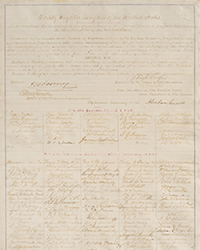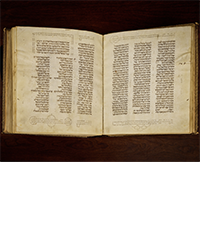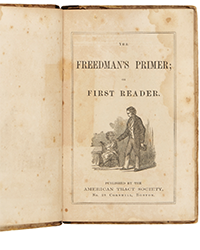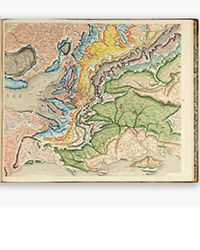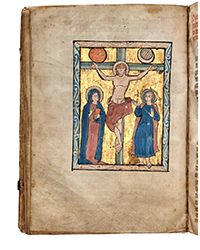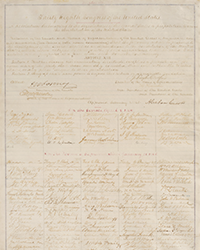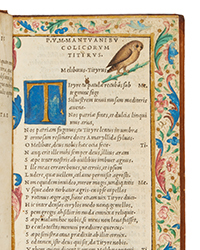Jonathan A. Hill, Bookseller, has created a catalogue of Japanese & Chinese Books, Manuscripts, and Scrolls. We can add to this that most of these items easily qualify for the label "antiquarian." Most are written in Japanese/Chinese characters, so reading will be a challenge to those not immersed in the language. However, for a great many, just as with many fine western books, it is the artwork that makes them so desirable. There are many manuscripts and hand-written scrolls filled with skilled drawings. And then, some items are in Latin languages, such as a series of items from San Francisco's Grabhorn Press published for the Book Club of California in the late 1950s and early 1960s. Here are a few of these selections.
We begin with one of those items you don't need to be able to read to appreciate. The title is "Shozoku shuyo sho" (costumes of the court comprehensively gathered and explained). Hill attributes this to the mid-Edo period. The Edo ran from 1603-1868. The text draws from three earlier texts whose timing places this in the 1700s. There are many illustrations in color, some in black and white. It is divided into five volumes. The first focuses in detail on the appropriate costumes for the emperor. They cover formal ceremonies and religious events. Detailed illustrations display such items of clothing as headgear, belts, jackets, trousers, inner wear, socks, shoes, fans, jewelry, and scepters. Later volumes work their way down in level of importance of people. The second covers the emperor "emeritus," crown price, other princes. Then there come costumes for attending aristocrats, then guards, and finally royal children. Hill notes that the "color illustrations are of very great complexity and beauty," with "ample use of gold." Item 4. Priced at $15,000.
Next we have a scroll with 61 color illustrations. I would not call these beautiful, as I might those from the last item, but that reflects on the subject matter rather than the artist's skill. Item 15 is an illustrated depiction of the Dissection of Heijiro. Heijiro was a thief, a recidivist who stole one time too many. He was executed in 1783. This was still a time when dissection of human bodies was frowned upon, but Heijiro had the honor of becoming a pioneer in the field in Japan. Hill writes that this scroll is "an important record of the most famous of all early human dissections to take place in Japan; these dissections materially changed the Japanese knowledge of human anatomy." At the time, Japan was relying on Chinese teachings to study human anatomy. The dissection of Heijiro played an important role in changing the orientation of the study of anatomy and medicine from old beliefs to those based on actual observation. These are detailed illustrations of body parts in various stages of dissection. They aren't pretty, but they are real life, or perhaps, real death. For example, we get a look at Heijiro's face and head as it was in life, but then with the flesh removed from the face, and then with the skullcap removed. The chest cavity is opened to display ribs and muscles, and then those are removed to show internal organs. Such exposed views are continued right down to the feet. The explanations of what we see were written by Genshun Koishi, a physician interested in western medicine, while the chief artist was Ranshu Yoshimura. $40,000.
Here is another anatomical scroll, but this one is focused on the human eye. You may think this scroll is watching you. It depicts nearly 200 pairs of eyes, suffering from various diseases. Eye diseases were common in the late Edo period in Japan due to malnutrition and infectious disease. This manuscript is typical of doctors treating eye diseases in Japan at the time, and is derived from Chinese medicine. The first images show eye diseases such as cataracts and inflammation, followed by pairs of eyes showing their structural relationships to the "five wheels." Those are five internal organs - heart, lung, liver, kidney, and spleen. Then there are relationships to the "eight boundaries," and from these, appropriate therapy can be determined. This is followed by pharmaceutical recipes, using such ingredients as gypsum, camphor, deer musk, herbs, ground oyster shells, mint, orange rinds, rhubarb, and animal horns. I have serious doubts about the science here or the efficacy of these remedies, but it probably wasn't any worse than the bloodletting going on in the West at the time. Item 6. $6,500.
This is a pair of finely illustrated scrolls that are very Japanese in design, but of great interest to American collectors. They illustrate the second visit to Japan of American Commodore Matthew Perry in 1854. Neither side knew very much about the other, and Perry certainly wasn't welcomed to their homeland by the Japanese. The United States wanted to open Japan to international trade, while Japan wanted to be left alone. Ultimately, Perry's warships convinced Japan of the benefits of trade. These scrolls depict some of the machinery on Perry's ships, such as a telegraph transmitter, a furnace, cannon, and steam engine. There is a miniature locomotive Perry brought as a gift. The Japanese were unfamiliar with trains. Perry and his Chief of Staff, Henry Adams, are also drawn. The five warships are depicted offshore, three rowboats filled with American sailors, a cannon, and America flag, four Americans in uniform, many American tools and armaments, and more. Item 42. $25,000.
Next is an album of drawings, but these are much prettier than dissected body parts or diseased eyeballs. Item 34 is an album of morning glory drawings, 62 pages of them from the late Edo period. Hill tells us that morning glories were brought to Japan from China, and were at first used for medicinal purposes. However, they soon became appreciated for their beauty, and in the 19th and 20th centuries, there were morning glory booms, similar to the tulip mania of 17th century Holland. Most of these drawings are in full color, with each labeled. The blossoms are shown in various stages of development, from buds to full bloom to wilting flowers. $9,500.
Jonathan A. Hill Bookseller may be reached at 646-827-0724 or jonathan@jonathanahill.com. The website is www.jonathanahill.com.


